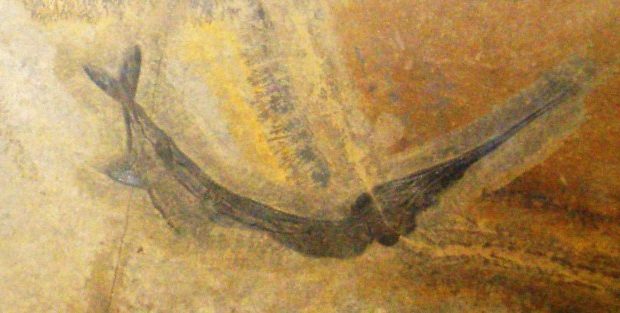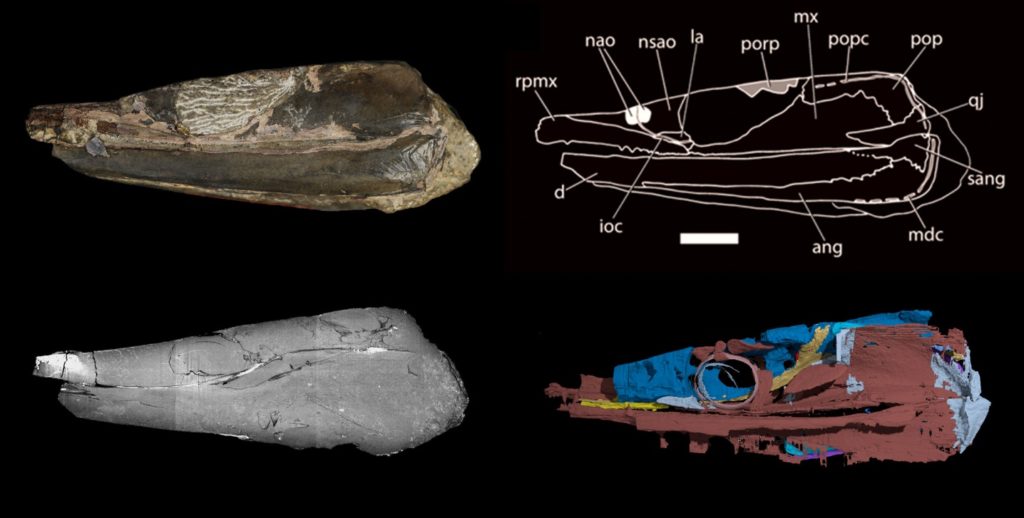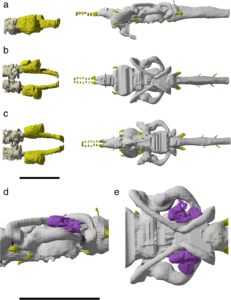
Due to our close connection to the land we live on, as well as the daily interactions we have with domesticates and wildlife around us, we may often forget that collectively, amphibians, reptiles, birds and mammals represent less than half of the ‘leaves’ of the vertebrate tree of life.
Indeed, over 50% of living species of vertebrates are ray-finned bony fishes (Actinopterygii), a clade that has been around for almost half a billion years. Despite being masked by an overall fish-like appearance, actinopterygians comprise fossil and living evolutionary lineages that are, in loose evolutionary terms, as distinct as those of frogs and humans.
†Saurichthyiformes were an iconic group of early actinopterygians, which reigned aquatic ecosystems for almost 80 million years and even survived the biggest mass extinction in the history of life.
Yet the origins of major ray-fin lineages remain obscure. The assignment of early actinopterygian fossils to the correct branch of the tree of life remains an obstacle to acquiring a more complete picture of vertebrate evolution, and its course through major extinction events.
Typically, ray-finned fossils are found crushed in two dimensions by overlying sediments. This does not allow the observation of tremendously important internal skeletal features (e.g. the braincase, sensory structures and gill bones). Luckily, on rare occasions, carcasses were encrusted quickly in pebble-shaped nodules that secured their three-dimensional preservation, protecting the integrity of internal structures.
Classical investigations, from the early 20th century, of the internal anatomy of 3D early actinopterygians still form the core of our knowledge on the subject. Early works have employed destructive techniques, such as serial grinding, to describe internal features. As one can imagine, these results were of limited accuracy and are non-reproducible, since the original specimens were destroyed in the process.
The latest Palaeozoic–Mesozoic †Saurichthyiformes were an iconic group of early actinopterygians, which reigned aquatic ecosystems for almost 80 million years and even survived the biggest mass extinction in the history of life. They were the first to evolve the typical ‘ambush predator’ (torpedo-like) body shape, which is nowadays encountered in gars, or needlefish.
Destructive investigations of the internal skeleton of †Saurichthyiformes, conducted in the 1920s, pointed towards a close relationship with modern paddlefishes and sturgeons (which are best known for their delicious eggs ‒ caviar). Although widely accepted, this hypothesized close relationship rested on weak anatomical arguments.
In this work, we revisited the internal anatomy of †Saurichthyiformes by employing computed X-ray microtomography on 3D fossils of two species of †Saurichthys from the Early Triassic of Nepal and East Greenland. This method is non-destructive, and results in high-resolution digital models that can be easily studied from different angles, enabling accurate comparisons with other animals.

We digitally reconstructed internal skeletal structures, such as the braincase, jaws, and gills. We also visualized the spaces that were, in life, occupied by the brain, cranial nerves and blood vessels, as well as the inner ear. This allowed us to infer the shape and/or course of the actual soft-tissue structures. Our reconstructions led to new anatomical discoveries, but also revealed critical flaws in classical works.
Amongst our new discoveries is the presence of large empty spaces in the snout. Additionally, we found that a bone (dermohyal), which was previously thought to be missing in †Saurichthys, was actually fused to another bone (hyomandibula). Both features are primitive. Interestingly, we found that the gill-cover bone architecture of †Saurichthys is very similar to that of modern sturgeons and paddlefishes.
To put this new anatomical knowledge in its evolutionary context, we compared †Saurichthys with a variety of fossil and living ray-finned fishes. With the help of specialized algorithms, we analyzed a large dataset of morphological characters from dozens of bony fishes, in order to trace evolutionary affinities on the basis of anatomical similarities.

Contrasting historical phylogenetic hypotheses, the evolutionary trees produced by our analyses do not recover †Saurichthyiformes as closely related to sturgeons and paddlefishes, implying that many of their similarities have likely evolved independently (convergently). However, the lack of internal skeletal data for many other early actinopterygians precludes a clear picture of the early ray-fin tree of life.
There will always be too many fossil fishes out there and not enough time (and resources) to study them. It might even seem that this work only scratches the surface of early actinopterygian evolution. Yet, through works like this, we are able to better locate specific morphological characters and also fossil species that are responsible for ‘reshuffling’ the branches of the largest partition of the vertebrate tree of life.
The unprecedented anatomical knowledge of the internal skeleton of †Saurichthyiformes will doubtlessly form a solid basis for further comparisons with new fossils. Moreover, our research highlights the fact that established classical interpretations of actinopterygian anatomy need to be critically reappraised in light of new material and modern methods of anatomical imaging.
Comments